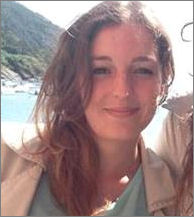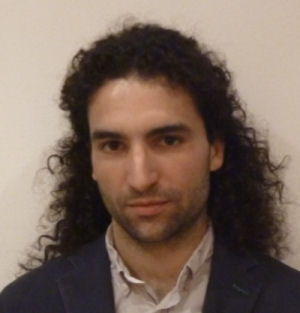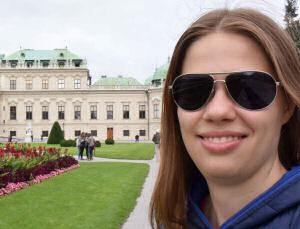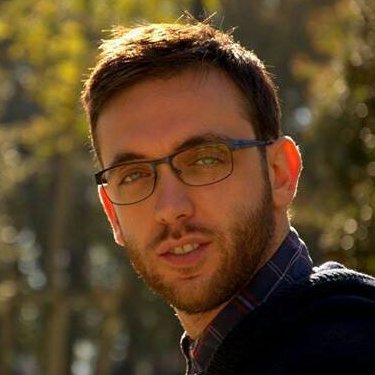Dottorandi CHI_MAT

Contacts: Questo indirizzo email è protetto dagli spambots. E' necessario abilitare JavaScript per vederlo.
Supervisors: Dott.ssa Emilia Bramanti, prof.ssa Stefania Giannarelli
Title: Quantification and monitoring of inorganic compounds relevant for environmental and health risk assessment
Abstract: The key-point of my research activity is the quantitation, speciation and monitoring of relevant inorganic contaminants by inductively coupled plasma mass spectrometry (ICP-MS), a technique characterized by greater speed and sensitivity, and by atomic fluorescence spectrometry (AFS), an alternative and low-cost technique compared to ICP-MS.
I am participating in a European project aimed to demonstrate the application of ecological and sustainable strategies for the control of bacterial infections in plants replacing traditional products based on copper. My participation to the project includes the speciation of copper and quantification of phytohormones in plants by HPLC-ICP-MS and HPLC-DAD-Fluorescence, respectively.
I am also developing a method for the photochemical vapor generation of organo-compounds of mercury, selenium and arsenic and their determination with AFS.
Publications:
• Ammazzini, S., Onor, M., Pagliano, E., Mester, Z., Campanella, B., Pitzalis, E., D’Ulivo, A. (2015) Journal of Chromatography A 1400 PP. 124 – 130
• Campanella, B., Onor, M., Biancalana, L., D'Ulivo, A., Bramanti, E. (2015) Analytical Biochemistry 483 PP. 27 – 33
• de Quadros, D., Campanella, B., Onor, M., Bramanti, E., Borges, D., D’Ulivo, A. (2014) Spectrochimica Acta Part B: Atomic Spectroscopy 101 PP. 312 – 319
• Campanella, B., Bramanti, E. (2014) Analyst 139 (17) PP. 4124-4153
• Campanella, B., Onor, M., Ferrari, C., D'Ulivo, A., Bramanti, E. (2014) Analytica Chimica Acta 843 PP. 1 – 6
• Campanella, B., Onor, M., D'Ulivo, A., Giannarelli, S., Bramanti, E. (2014) Analytical Chemistry 86 (4) PP. 2251 – 2256
• Campanella, B., Rivera, J.G., Ferrari, C., Biagi, S., Onor, M., D'Ulivo, A., Bramanti, E. (2013) Analytical Chemistry 85 (24) PP. 12152 – 12157
• Campanella, B., Onor, M., Mascherpa, M.C., D'Ulivo, A., Ferrari, C., Bramanti, E. (2013) Analytica Chimica Acta 804 PP. 66 – 69
Oral communications at congress:
"Proteomics low-cost: study of proteins with probe labelling mercurial coupled to atomic fluorescence spectrometry with chemical vapor generation (CVG-AFS)".
Campanella, B., Rivera, J.G., Ferrari, C., Biagi, S., Onor, M., D'Ulivo, A., Bramanti, E.
XXIV Congresso della Divisione di Chimica Analitica della Società Chimica Italiana, Sestri Levante, Sep 2013
[Book of abstract pg. 65]
Poster communications at congress:
Title: “Rapid clean-up strategy based on molecularly imprinted polymers for the determination of 3- indoleacetic acid in plant extracts”.
B. Campanella, E. Pulidori, M. Onor, S. Tegli, P. Bogani, M. Cerboneschi,
E. Passaglia, A. D’Ulivo, E. Bramanti
XXV Congresso della Divisione di Chimica Analitica della Società Chimica Italiana, Sestri Levante, Sep 2015
[Book of abstract pg. 56]
Title: “Hyphenated Techniques - protein determination and characterization”.
E. Bramanti, B. Campanella, M. Onor, A. D’Ulivo
XXXIX Colloquium Spectroscopicum Internationale” (Figueira da Foz, Portugal), Aug 2015
[Book of abstract pg. 30]
Title: “Photochemical vapor generation of selenium(IV) and arsenic(III) with commercial and homemade UV lamps”.
A. Menciassi, B. Campanella, M. Onor, A. D’Ulivo, E. Bramanti, C. Ferrari, I. Longo
XXXIX Colloquium Spectroscopicum Internationale” (Figueira da Foz, Portugal), Aug 2015
[Book of abstract pg. 123]
Title: “Thallium determination in contaminated water and biological samples: a population-based case–control study in Valdicastello Carducci and Pietrasanta (Lucca, Italy)”.
E. Bramanti, M. Onor, B. Campanella, A. D’Ulivo, S. Biagi, G. Rossi, O. Curzio, R. Giannecchini, M. D’Orazio, R. Petrini
XXXIX Colloquium Spectroscopicum Internationale” (Figueira da Foz, Portugal), Aug 2015
[Book of abstract pg. 254]
Title: “Determination of carboxylic acids in biological matrices by GC/MS following single-step aqueous derivatization with triethyloxonium tetrafluoroborate”.
D. Ferraro, M. Onor, B. Campanella, S. Tegli, E. Bramanti, S. Giannarelli,
A. D’Ulivo and E. Pagliano
XXXIX Colloquium Spectroscopicum Internationale” (Figueira da Foz, Portugal), Aug 2015
[Book of abstract pg. 277]
Title: “Effect of the use of copper compounds on plants for the control of bacterial diseases”.
B. Campanella, M. Onor, A. D’Ulivo, S. Tegli, P. Bogani, M. Cerboneschi, E. Bramanti
XXXIX Colloquium Spectroscopicum Internationale” (Figueira da Foz, Portugal), Aug 2015
[Book of abstract pg. 320]
Title: “Low-cost proteomics: study of proteins with probe labeling mercurial coupled to atomic fluorescence spectrometry with chemical vapor generation (CVG-AFS)”.
Campanella, B., Rivera, J.G., Ferrari, C., Biagi, S., Onor, M., D'Ulivo, A., Bramanti, E.
XXXVIII Colloquium Spectroscopicum Internationale” (Tromsø, Norvegia), Jun 2013
[Book of abstract pg. 19]
Supervisor: Prof. Gloria Uccello Barretta
Supervisor: Prof. Caterina Cristallini - Prof. Maria Grazia Cascone
Title: Development of new intelligent nano-systems for the treatment of cardiovascular diseases and cancer
Abstract:
Cardiac disease and cancer are the main causes of mortality in the western world.
The traditional treatment foresees the administration of high doses of active principle which is unable to reach the target tissue in a selective way without causing side effects. Moreover high concentrations are not reached in the target tissues.
In this sense the creation of intelligent polymeric nanosystems is particularly promising because they are able to release the drug in a specific, controlled and quantitative way.
Nanosystems can be designed so as to a) encapsulate a high quantity of drug, b) functionalized by ligands with high specificity and affinity towards the target tissue, c) contain different types of drugs for treatment requiring combined action, d) cross biological barriers in different way from traditional drugs.
The main aim of this research project is concerned with the design and creation of new nanoparticles using multifunctional polymeric materials for the release of bioactive agents toward a specific pathological area of the body.
The ability to load modified nanoparticles on polymeric scaffolds for in situ release of active principles which can promote the regeneration of the tissue will be also evaluated.
Growth factors and gene specific oligonucleotidic drugs (DNA, RNA, ribozymes) which can guide the regeneration of cardiovascular tissue or selectively inhibit the expression of crucial genes in tumoral tissues will be considered.
Project will be structured in the following phases:
• Synthesis and characterization of the nanoparticles obtained by the copolymerization of monomers selected on the bases of chemical and physical characteristics of the active principle to be included. The most suitable method of production will be defined.
• Preparation of intelligent nanoparticles in nano-capsular form so as to obtain an internal reserve with a high content of the active principle. Innovative functionalization techniques will be used to maximise the ability of the nanocarriers to penetrate biological barriers and favour the internalization in the specific cells. These results will be obtained by controlling their shape and size during polymerization, by decorating their surface with molecules and introducing specific sites using Molecular Imprinting technique.
• Preparation and characterization of hollow fibre scaffolds modified with intelligent nanoparticles. Hydrogel structures made of biological and/or synthetic polymers will be designed in the form of hollow fibres using dry-wet spinning techniques. Suitable deposition processes will be identified to incorporate the nanocarriers on the scaffolds surface.
Morphological, physico-chemical, functional, mechanical and biological characterizations of nanocarriers and integrated scaffolds/nanocarriers systems will be carried out using SEM, light scattering, HPLC, FT-IR Chemical Imaging analysis, DMA analysis and cell culture methods.
Supervisor: Prof.

Contacts: Questo indirizzo email è protetto dagli spambots. E' necessario abilitare JavaScript per vederlo.
Supervisor: Prof Fabio Marchetti
Title: Design, Synthesis and Evaluation of New Transition Metal Complexes as Anticancer Agents
Abstract: Transition metal complexes have been at the forefront of chemotherapy since the discovery of cisplatin's activity back in the 1960s. In the last decades, some classes of ruthenium complexes emerged for their promising cytotoxic and/or anti-metastatic properties. In particular, much work has focused on piano-stool Ru(II) complexes of the type [(η6-arene)RuXYZ]0/+ where X, Y, Z are three coordination positions occupied by bidentate or monodentate ligands. The piano-stool motif offers much scope for molecular design, by varying the nature and the size of the substituents belonging to each ligand.
One of the main problems associated with cisplatin and other metal-based chemotherapeutic agents is their low selectivity, i.e. ability to discriminate between tumoral and healthy cells. In this context, the synthesis of metal complexes containing organic fragments with known biological functions (bioactive molecules) can lead to enhanced anticancer activities, if the target of the bioactive molecule is over-expressed or uniquely expressed in cancer cells.
In this regard, we focused our attention of enzyme inhibitors. Ethacrynic acid (EA) is an inhibitor of Glutathione-S-Transferases (GST), a class of enzymes involved in cellular detoxification. GST enzymes show an increased activity in some types of cancerous cells and this contributes to drug resistance. Ethacrynic acid and its derivatives reduce drug resistance by inhibiting GST enzymes. Hence, the EA skeleton has been successfully incorporated in ruthenium(II) and Platinum(II) complexes with very promising pharmacological results in vitro.
My PhD project is aimed to the synthesis, characterization and evaluation of the anticancer activity of new transition metal complexes functionalized with small bioactive molecules. The ligands will be prepared by coupling Ethacrynic acid or other enzyme inhibitors, respectively, with molecules of different structures and containing suitable donor atoms for metal-coordination (N, O, P). Then the ligands will be coordinated to Ruthenium-based skeletons with a known anticancer activity. Later on, analogous procedures may be employed for the preparation of new Pt, Os and Ir complexes based on intensively-investigated structures. The new metal complexes will be characterized by analytical, spectroscopic and electrochemical techniques. Then, they will be tested in vitro against a panel of cancer cell lines thus giving information about possible synthetic modifications for optimizing the drug action.
Several collaborations with Italian and foreign investigators/research groups are planned, in particular with Prof. Paul J. Dyson (EPFL, Lausanne), a "pioneer" of Ruthenium anticancer drugs.
Publications:
• B. Campanella, M. Onor, L. Biancalana, A. D’Ulivo, E. Bramanti, Ovalbumin labeling with p-hydroxymercurybenzoate: The effect of different denaturing agents and the kinetics of reaction, Anal. Biochem. 2015, 483, 27-33.
• L. Biancalana, M. Bortoluzzi, C. Forte, F. Marchetti, G. Pampaloni, Structural characterization of α-amino acid complexes of molybdates: a spectroscopic and DFT study, RSC Adv. 2015, 5, 9010-9018.
• F. Marchetti, G. Pampaloni, L. Biancalana, Activation reactions of 1,1-dialkoxoalkanes and unsaturated O-donors by titanium tetrafluoride, Inorg. Chim. Acta 2012, 385, 135-139.
Conference proceedings:
• G. Agonigi, L. Biancalana, P. J. Dyson, F. Marchetti, G. Pampaloni, E. Păunescu, T. Riedel, S. Zacchini, Synthesis and Antiproliferative Activity of New Ruthenium Complexes with Ethacrynic Acid-Modified Pyridine- and Triphenylphosphine-Ligands. XXI EuCOMC International Conference on Organometallic Chemistry, Bratislava, 5-9 July 2015 (poster presentation); X EuCOMC International School of Organometallic Chemistry, Camerino, 5-9 September 2015 (oral and poster presentation).
• L. Biancalana, M. Bortoluzzi, C. Forte, F. Marchetti, G. Pampaloni, Dioxidomolybdenum(VI) complexes of α-Amino Acids. X EuCOMC International School of Organometallic Chemistry, Camerino, 5-9 September 2015 (poster presentation).
Supervisor: Prof. Anna Iuliano
Title: "Innovative non infringing synthesis of Active Pharmaceutical Intermediates"

Contacts: Questo indirizzo email è protetto dagli spambots. E' necessario abilitare JavaScript per vederlo.
Supervisors: Benedetta Mennucci
Title: Development of classical models for the description of QM properties in photoinduced processes
Abstract:
Carotenoids are important actors both in light-harvesting and photoprotection functions of photosynthetic pigment-protein complexes. A deep theoretical investigation of this multiple role is still missing due to the difficulty of describing the delicate interplay between electronic and nuclear degrees of freedom. A possible modelling strategy is to combine accurate QM methods with classical MD. To do that however, accurate force-fields (FF) are necessary. This PhD work has the objective to develop a new FF for different carotenoids present in LH complexes.
Publications:
PRANDI, INGRID G.; VIANI, LUCAS ; ANDREUSSI, OLIVIERO ; MENNUCCI, BENEDETTA . Combining classical molecular dynamics and quantum mechanical methods for the description of electronic excitations: The case of carotenoids. Journal of Computational Chemistry, v. 37, p. 981-991, 2016
CUPELLINI, LORENZO ; JURINOVICH, SANDRO ; PRANDI, INGRID G. ; CAPRASECCA, STEFANO ; MENNUCCI, BENEDETTA . Photoprotection and triplet energy transfer in higher plants: the role of electronic and nuclear fluctuations. PCCP. Physical Chemistry Chemical Physics (Print), v. 18, p. 11288-11296, 2016
JURINOVICH, SANDRO ; VIANI, LUCAS ; PRANDI, INGRID G. ; RENGER, THOMAS ; MENNUCCI, BENEDETTA . Towards an ab initio description of the optical spectra of light-harvesting antennae: application to the CP29 complex of photosystem II. PCCP. Physical Chemistry Chemical Physics (Print), v. 17, p. 5197-14416, 2015.
ANDREUSSI, OLIVIERO ; CAPRASECCA, STEFANO ; CUPELLINI, LORENZO ; GUARNETTI-PRANDI, INGRID; GUIDO, CIRO A. ; JURINOVICH, SANDRO ; VIANI, LUCAS ; MENNUCCI, BENEDETTA . Plasmon Enhanced Light Harvesting: Multiscale Modeling of the FMO Protein Coupled with Gold Nanoparticles. The Journal of Physical Chemistry. A, v. 119, p. 141205113938001-5206, 2014.
Poster communications at congress:
Combining classical MD and QM methods for the description of electronic excitations: the case of carotenoids. PRANDI, INGRID G.; VIANI, LUCAS ; ANDREUSSI, OLIVIERO ; MENNUCCI, BENEDETTA. DCTC, III Congresso Nazionale della Divisione di Chimica Teorica e Computazionale della Società Chimica Italiana, Roma 14-16/12/2015.
A DFT Based Classical Force-Field for Carotenoids in Light-Harvesting Complexes of Plants. PRANDI, INGRID G.; VIANI, LUCAS ; ANDREUSSI, OLIVIERO; CAMPETELLA, MARCO ; MENNUCCI, BENEDETTA. CHITEL, Congress of Theoretical Chemists of Latin Expression, Turin 26-31/07/2015.
CP29 and LHC2: a comparison of site energies and excitonic couplings. PRANDI, INGRID G. ; JURINOVICH, SANDRO ; VIANI, LUCAS ; MENNUCCI, BENEDETTA. STC, 50th Symposium on Theoretical Chemistry, Wien 14-18/09/2014.
Supervisor: Prof.
Supervisor: Prof.

Contacts: Questo indirizzo email è protetto dagli spambots. E' necessario abilitare JavaScript per vederlo.; Questo indirizzo email è protetto dagli spambots. E' necessario abilitare JavaScript per vederlo.
Supervisors: Prof. Andrea Pucci (Unipi); Dott. Riccardo Rausa (Eni S.p.A.)
Title: New surfactants for water and organic nanostructures dispersions for high performance applications
Abstract:
Carbon nanotubes (CNTs) are a third allotropic form of carbon which represent a dominant class of nanostructured materials whose unique mechanical, electrical and thermal properties depend critically on their structural perfection and high aspect ratio (typically >102). Single-walled CNTs (SWCNTs) consist of single graphene sheets (monolayer of sp2 bonded carbon atoms) wrapped into cylindrical tubes with a diameter ranging from 0.7 to 2 nm and lengths up to micrometers. Multi-walled CNTs (MWCNTs) consist of concentric assemblies of SWCNTs and are therefore characterized by larger average diameters. The exceptional properties shown by SWCNTs and MWCNTs support their use for a variety of applications, ranging from additives for strong and lightweight materials to nanometer-sized electronic devices and electrochemical sensors. Nevertheless, their large-scale utilization is questionable due to the strong van der Waals interactions between individual nanotubes, which hinder a uniform dispersion at the nanoscale level. Ultrasonication, covalent and non-covalent functionalization of CNTs have proven to be highly effective in their exfoliation and dispersion in several media and polymer matrices. This work is focused on the development of new surfactants for covalent and non-covalent functionalization in collaboration with the Eni R&D laboratories in San Donato Milanese.
Publications:
T. Biver, F. Criscitiello, F. Di Francesco, M. Minichino, T. Swager, A. Pucci, MWCNT/perylene bisimide water dispersions for miniaturized temperature sensors, RSC Advances, 5 (2015) 65023-65029.
Oral communications at congress:
Dispersioni di MWCNT per la realizzazione di sensori di temperatura miniaturizzati - XXI Convegno dell'Associazione Italiana di Scienza e Tecnologia delle Macromolecole – Torino 2014 (Winner of Macrogiovani 2014 prize)
A spectroscopic study on MWCNT dispersed by a fluorescent dye – Year of Light Congress – Pisa 2015
Poster communications at congress:
Non-covalently functionalized MWCNTs for the preparation of miniaturized temperature sensors – EPF 2015 – Dresden 2015
![]()
Contacts: Questo indirizzo email è protetto dagli spambots. E' necessario abilitare JavaScript per vederlo.
Supervisors: Giovanni Grannucci, Maurizio Persico, Inés Corral e Jordi Muñoz-Muriedas
Title: Phototoxicity and stability of pharmaceutical excipients and drugs
Abstract:
Light interaction with drugs and pharmaceutical excipients can result in the loss of potency, inactivation or in the formation of cytotoxic metabolites with side effects for the patients. In the course of manufacture, storage or after administration, pharmaceuticals may be exposed to different light sources driving these formulations to their excited states. In the absence of efficient decay mechanisms, the temporary energy trapping of these systems in stable singlet or triplet excited intermediates would enhance the probability of undergoing photoreactions. In particular, if long-lived triplet excited states happen to be populated, they could initiate photosensitization and/or charge or energy transfer reactions with other surrounding molecules, leading to cytotoxic side products, such as singlet oxygen or free radicals, able to oxidize a large number of substances, including cell components. The aim of the present project is to explore the photostability/phototoxicity of several organic systems used as excipients or drugs in pharmaceutical formulations.
Publications:
Oral communications at congress:
• Phototoxicity and stability of pharmaceutical excipients and drug
1st Annual Workshop; Paris, France; July 2016.
• Phototoxicity and stability of pharmaceutical drugs
Mid-term Meeting; Madrid, Spain; December 2016.
• Phototoxicity of Non-Steroidal Anti-Inflammatory Drugs insight through In-Silico Calculations
6th TCCM Workshop, Barcelona, Spain; September 2017.
Poster communications at congress:
• Exploring photostability of drugs with theoretical methods
8th MQM; Uppsala, Sweden; June 2016.
• Phototoxicity and stability of pharmaceutical excipients and drug
1st Annual Workshop; Paris, France; July 2016.
• Ab initio approach to drug photosensitivity
Mid-term Meeting; Madrid, Spain; December 2016.
• In-silico study to predict phototoxicity of non-steroidal anti-inflammatory drugs
The British Toxicology Society, Liverpool, UK, April 2017.
• Can we assess phototoxicity of non-steroidal anti-inflammatory drugs through in-silico calculations?
UKQSAR, Berkshire,UK, April 2017
• Understanding the behaviour of NSAIDS drugs upon light exposure with in silico modelling, 2nd TCCM Workshop, Leuven, Belgium, July 2017
• Excited States Insight to Assess Phototoxicity of Non-Steroidal Anti-Inflammatory Drugs,
WATOC’17, Munich, Germany, August 2017.
• Phototoxicity of non-steroidal anti-inflammatory drugs insight through in-silico calculations,
11th EUCO-TCC, Barcelona, Spain, September 2017.
• Can in-silico calculations assess phototoxicity of non-steroidal anti-inflammatory drugs?
EuroTox, Bratislava, Slovakia, September 2017.
• In silico modelling insight into assessing NSAIDS excited states deactivation mechanisms, 2nd Annual Workshop, Leuven, Belgium, July 2017.
• Exploring light activated mechanisms in Non-steroidal anti-inflammatory drugs,
6th TCCM Workshop, Barcelona, Spain, September 2017.
![]()
Contacts:
Supervisors:
Title:
Abstract:
Publications:
Oral communications at congress:
Poster communications at congress:
![]()
Contacts:
Supervisors:
Title:
Abstract:
Publications:
Oral communications at congress:
Poster communications at congress:
![]()
Contacts:
Supervisors:
Title:
Abstract:
Publications:
Oral communications at congress:
Poster communications at congress:
Contacts:
Supervisors:
Title:
Abstract:
Journal articles:
Publications:
Oral communications at congress:
Poster communications at congress:
More...
![]()
Contacts:
Supervisors:
Title:
Abstract:
Publications:
Oral communications at congress:
Poster communications at congress:
![]()
Contacts:
Supervisors:
Title:
Abstract:
Publications:
Oral communications at congress:
Poster communications at congress:
